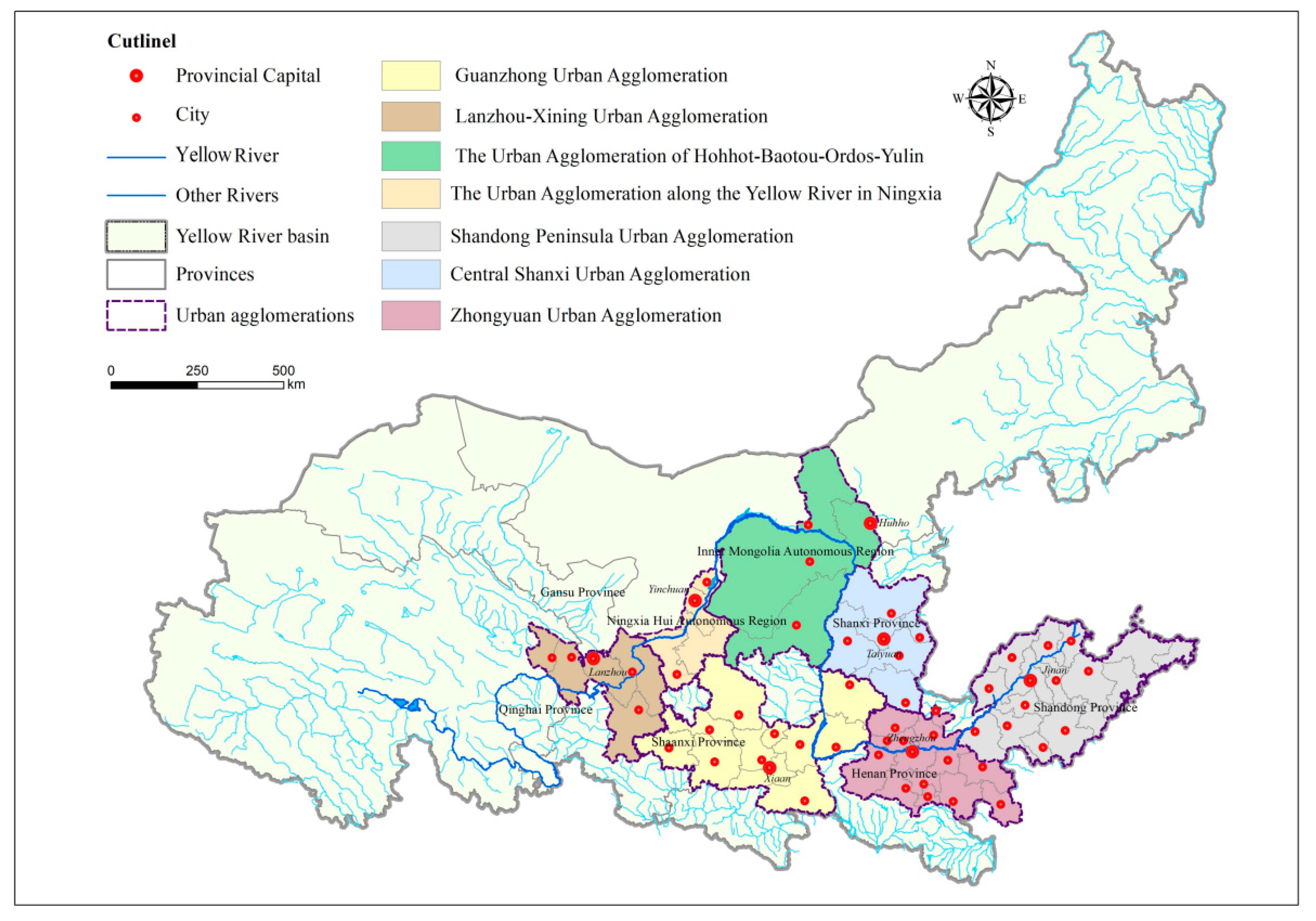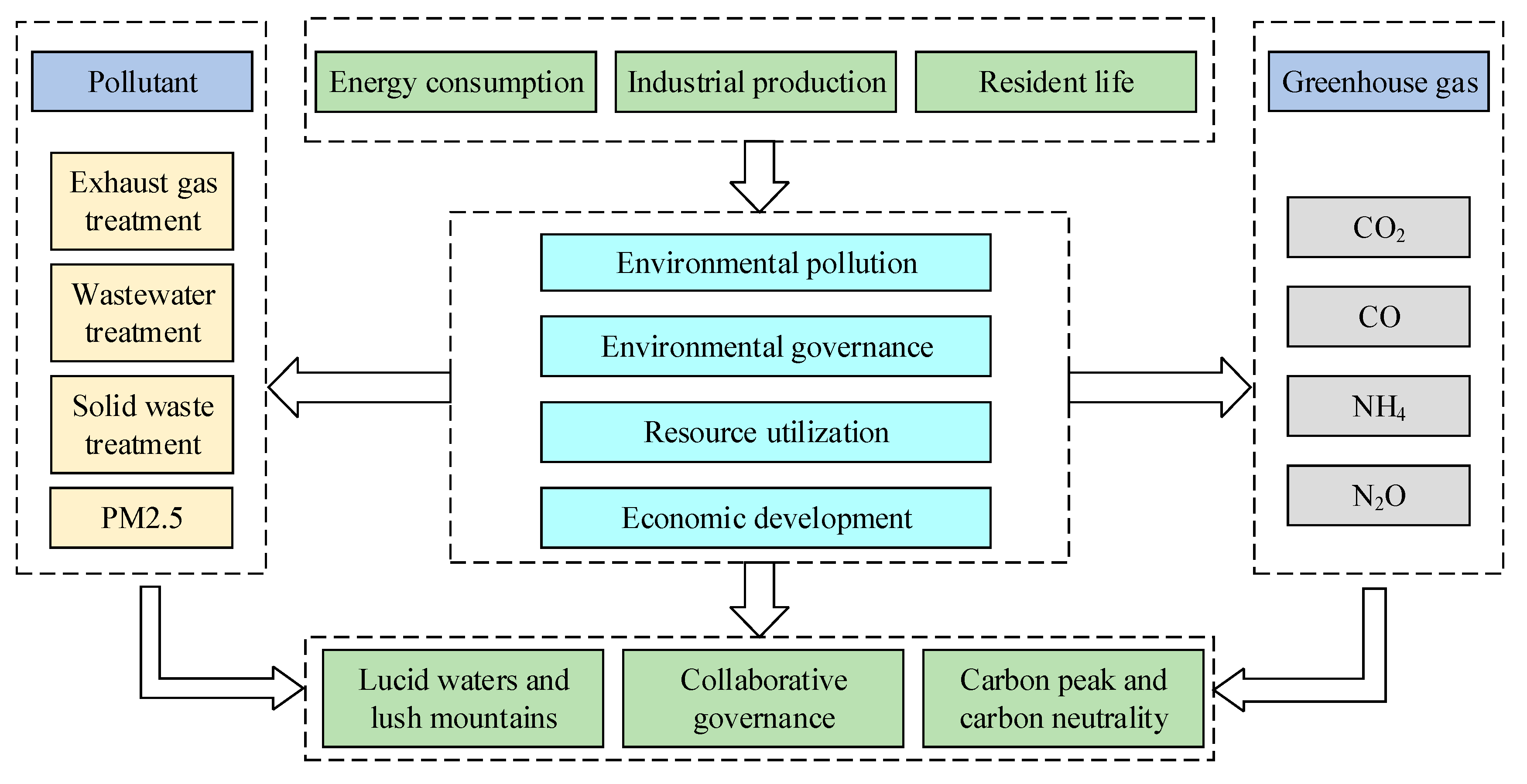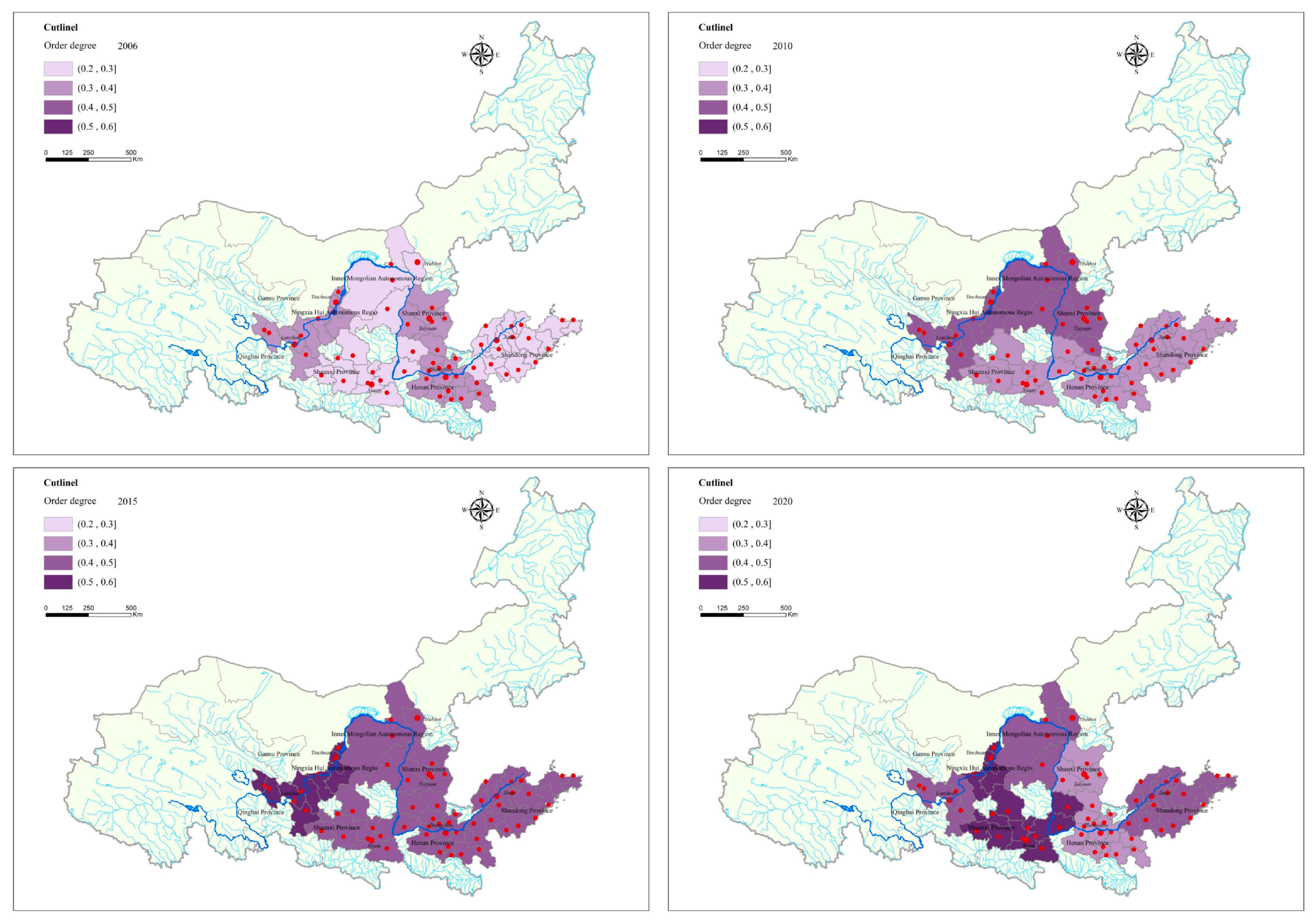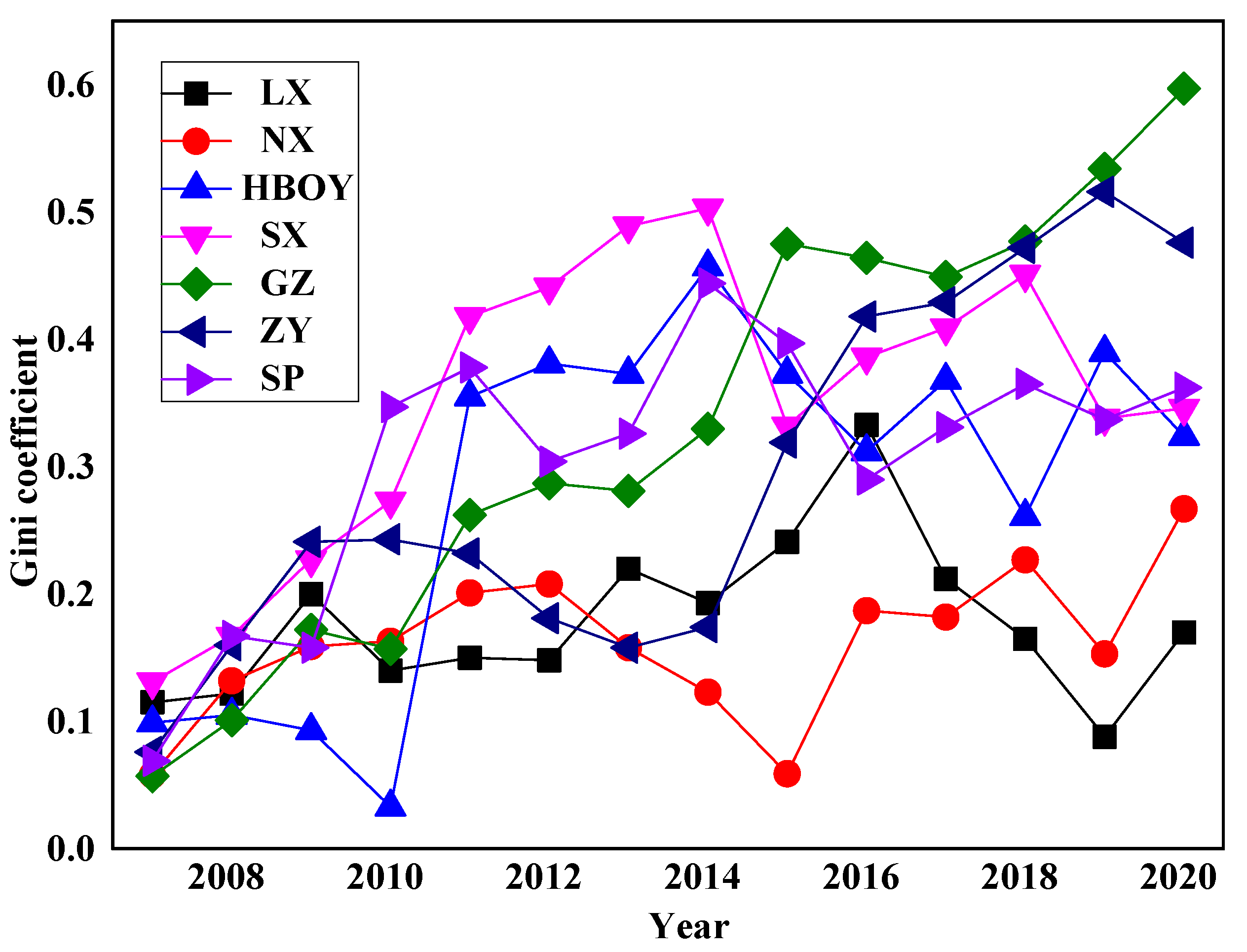1. Introduction
As the world economy rebounds from the COVID-19 crisis, the current trend of relying on coal to promote economic growth is continuing, and global energy related to CO
2 emissions is exhibiting an upward trajectory. The sixth IPCC report issues the most severe warning so far: human behavior is accelerating the process of global warming at an alarming rate, and the global climate, oceans, and atmosphere are facing imminent and terrible risks [
1]. In accordance with data recently published by IEA, China is currently one of the largest CO
2 emitters in the world and predominant in changing the global climate [
2]. Moreover, based on the EPI Assessment in 2022, China’s air quality ranked 160th among 180 countries and regions, and poor air quality poses a serious threat to public life and health [
3]. The relevant research reveals that haze pollution has a negative environmental impact on residents’ health [
4], urban crime rates [
5], personal well-being [
6], regional innovation vitality [
7], and so forth.
Both CO
2 and air pollutants mainly originate from combustion of fossil fuels in human production and life. Because of their homology and synchronization in terms of the production process and the mutual effect of the hazard generation process, collaborative governance of pollution reduction and carbon abatement (PRCA) is theoretically feasible [
8,
9]. Based on the previous literature, it was found that the synergistic effect was derived from the associated benefits proposed by Ayers and Walter [
10]. The associated benefits were used to show that the emission reduction measures related to greenhouse gases, such as CO
2, could reduce generation of other pollutants. Thereafter, the IPCC [
11] formally put forward the concept of synergy in their third assessment report. Synergy refers to the phenomenon in which implementation of a certain pollutant emission reduction measure generates other environmental benefits while achieving pollutant emission reduction. The existing research primarily focuses on the synergy effect of carbon abatement policies on emission reduction of air pollutants, the synergy effect of environmental governance on carbon abatement and climate change, countermeasures for reducing pollution and carbon, and evaluation of their synergy effects, etc.
Climate warming has attracted academic attention, and various scholars have discussed synergy effects related to relevant carbon abatement policies on reduction of atmospheric pollutants. Relevant policy research covers international climate agreements [
12], construction of a carbon trading market [
13], carbon tax [
14], vegetation restoration [
15], energy policy [
16], etc. The research regarding synergy includes improvement of air quality [
17], residents’ health [
18], the ecological environment [
19], energy security, and economic aspects [
20], etc. For example, Ramanathan and Xu confirmed that the energy sector carried out large-scale decarbonization according to the requirements of the Copenhagen Agreement, which reduced carbon emissions and decreased emissions of ozone, methane, and black carbon (BC) [
21]. Vandyck et al. stated that, if the emission reduction commitments of the Paris Agreement could be met, air quality could be greatly improved globally and the synergistic effects of emission reduction could offset expenditure from climate policies [
22]. By studying ASEAN countries, Anser et al. revealed that financing of low-carbon energy could reduce air pollution and improve the environment [
23]. Yan et al. argued that the low-carbon city pilot (LCCP) policy could curb haze pollution by improving industry structure, boosting technical innovation, and decreasing energy consumption [
24]. Jin et al. empirically analyzed the synergistic effect of low-carbon technological innovation on haze pollution in 30 provinces of China from 2006 to 2018, showing that low-carbon technological innovation inhibited air pollution and produced a synergistic effect of positive externalities between regions in the long run [
25].
Environmental governance studies demonstrate that reducing discharge of air pollutants, solid waste, and wastewater pollutants is a good way to attain environmental governance, and reducing emissions of pollutants can bring about such synergistic effects as carbon emission reduction and climate change. Okorn et al. verified synergy of pollutant emission reduction by simultaneously monitoring air pollutant emissions and CO
2 emissions in a community in Los Angeles [
26]. Peng Wen et al. conducted a scenario simulation focused on the industrial policy of reducing pollution and carbon. They claimed that a 10% increase in terms of energy efficiency of industrial sectors would have huge benefits for China’s air quality, public health, and climate [
27]. Wang et al. studied synergy effects related to decreasing carbon discharge and air pollution during execution of the pilot policy for low-carbon cities. They found that the policy of low-carbon cities significantly reduced concentrations of CO
2 and PM
2.5, and the co-control effect of decreasing carbon discharge and air pollution was remarkable [
28].
In recent years, most scholars have introduced multiple indicators to discuss the synergistic effect of PRCA, and measures to improve PRCA fall into three categories: technical improvement [
29], structural adjustment [
30], and supervision and management [
31]. Using a DEA window analysis, Zou gauged the input and output efficiency of controlling industrial pollution, revealing that China’s overall efficiency in controlling industrial pollution exhibited a downward tendency in the study period. They posited that improving efficiency in controlling industrial pollution was essential for degrading pollution discharge and attaining carbon neutralization and carbon peak [
32]. Anderson assessed the influence of green infrastructure productive applications on air pollution and CO
2 concentration across different agricultural forms of production, showing that productive application of green infrastructure was as beneficial as nonproductive applications in reducing ozone, nitrogen dioxide, and CO
2 concentration [
33]. By comparing the regional differences in PRCA collaborative governance in China’s three leading urban agglomerations, Di Qianbin et al. revealed that the internal differences in degree of PRCA collaborative governance in Hebei, Tianjin, and Beijing gradually decreased and the internal differences in the Yangtze River Delta remained essentially stable, while the internal differences in the Pearl River Delta fluctuated greatly [
34].
Urban agglomerations are the chief drivers of regional economic development and the places with the highest concentrations of carbon discharge and air pollution [
35]. With increasing mobility of the economy, resources, and other elements in the regional urban network, isolated cities are gradually evolving into closely linked urban agglomerations. However, as urban agglomerations develop, they also face multiple pressures, such as addressing climate change, ecological conservation, and economic growth [
36]. From the perspective of urban agglomerations, studying, planning, and promoting PRCA collaborative governance in urban agglomerations may represent significant avenues through which to promote overall green conversion in economic and social growth and thoroughly improve the quality of the ecological environment. As an important center of the chemical, energy, and production industries, the Yellow River Basin has a vulnerable climate with fragile ecology and concentrated carbon emissions and pollution. The imbalance and state development are inadequate. It is urgent to steadily move towards carbon abatement, pollution reduction, and high-quality development in the basin by shifting the role of urban agglomerations from point to area. At present, various elements need to be studied thoroughly, such as the synergy effect of PRCA in urban agglomerations in the basin, the features of its spatiotemporal evolution pattern, and the factors that affect effectiveness of regional coordinated governance of urban agglomeration for reducing pollution and carbon. Therefore, in this study, we constructed an evaluation index system for PRCA collaborative governance in urban agglomerations using the dimensions of environmental pollution, environmental governance, resource utilization, and economic development. In addition, we explored the order degree and overall synergy degree of PRCA collaborative governance in urban agglomerations in the basin from 2006 to 2020 using models such as synergy of composite system. Moreover, we revealed regional variances in PRCA collaborative governance degree using the Gini coefficient and Theil index. On this basis, the paper classifies the basin’s urban agglomerations into regional collaborative governance groups by dividing the governance boundaries and using other methods in order to explore the factors affecting PRCA collaborative governance therein. We propose corresponding policy recommendations with a view to providing a reference with which to optimize PRCA collaborative governance in the urban agglomerations in the basin. This study provides an empirical reference for formulating differentiated collaborative governance strategies for PRCA, comprehensive green and low-carbon economic and social transformation programs, and high-quality green development paths in urban agglomerations, which is of certain theoretical and practical significance.
The main contributions of this paper are as follows: first, regarding investigation of level of inter-regional PRCA collaborative governance, the existing studies are mainly conducted from a single dimension, while this study establishes the assessment index system of PRCA collaborative governance in four dimensions. Second, the paper reveals the spatiotemporal evolution features of PRCA collaborative governance level on urban agglomeration scale, measures PRCA collaborative governance degree of urban agglomerations using the correlation coefficient matrix and composite system synergy degree, and analyzes regional differences in PRCA collaborative governance of urban agglomerations by combining the Gini coefficient and Thiel index. Finally, this paper discusses the factors that affect PRCA collaborative governance in the basin’s urban agglomerations and explores the impact of different factors in urban agglomerations on PRCA collaborative governance.
The remaining sections are arranged as follows.
Section 2 introduces a regional overview of the Yellow River Basin and establishes an assessment index system for PRCA collaborative governance.
Section 3 presents and explains the research methods.
Section 4 discusses the spatiotemporal evolution features of and regional differences in PRCA collaborative governance in the basin’s urban agglomerations.
Section 5 explores the extent to which different affecting factors play a role in PRCA collaborative governance in the basin’s urban agglomerations. Finally, conclusions are offered in the final section.
5. Analysis of Affecting Factors
5.1. Model Specification
Based on research concerning the factors influencing PRCA collaborative governance synergy, we analyzed the influence of the variances among these influencing factors on PRCA collaborative governance synergy within the group. The model was established as follows:
where
refers to governance group,
represents year,
indicates PRCA collaborative governance synergy of
governance group in
year,
denotes constant term,
denotes coefficient of influencing factors,
is standard deviation of influencing factors within governance group,
is mean value of influencing factors in governance group,
represents individual fixation effects, and
denotes stochastic error terms.
5.2. Variable Selection
Based on Model (9), PRCA synergy degree (SD) expresses the variables explained in this study. When selecting explanatory variables, taking the existing literature into consideration, we extracted six indicators to probe the factors that affect PRCA synergy degree (as shown in
Table 5): industrial structure [
51,
52,
53,
54,
55], environmental regulation [
56,
57], economic growth [
58,
59,
60,
61,
62], energy consumption [
63,
64,
65], greening construction [
66,
67], and opening-up [
68,
69].
(1) Industrial structure variance. Industry is an essential driving force for economic and social development in the basin’s urban agglomerations and represents the main source of local air pollutants and carbon emissions. At present, the industrial structure of the basin’s urban agglomerations is composed of the heavy chemical and energy industries, which causes obvious problems, such as extensive industrial development and a low proportion of technology-intensive industries. Therefore, the proportion of secondary industry to GDP was employed to reflect the industrial structure, and the relative dispersion of the ratio of secondary industry to GDP was used to express regional differences in terms of industrial structure in this paper.
(2) Environmental regulation variance. From the perspective of public economics, as a public product with strong positive externality, environment is essentially a public service provided by the government. Environmental governance investment comes from government subsidies, enterprise self-financing, and bank loans, but it is ultimately affected by work of local governments. However, gravity of environmental pollution in the basin’s urban agglomerations is disproportionate to environmental protection investment. Moreover, there is a certain deviation that makes environmental governance investment fail to function as it should, i.e., to improve the environment. Therefore, this paper uses environmental governance investment to characterize environmental regulation and introduces relative dispersion of environmental governance investment to reflect the variances in environmental regulation between regions.
(3) Economic growth variance. Improvement in economic development tends to impact regional industrial structure, consumption structure, and other aspects. On the one hand, residents in areas with low economic development are more willing to trade environment for growth. On the other hand, in order to gain political support, local governments interfere in implementation of environmental policies in exchange for local economic growth. Accordingly, variance in economic development can affect the regional synergy of environmental governance. Therefore, in this paper, GDP per capita is employed to represent economic growth degree, and relative dispersion of GDP per capita is applied to reflect variances in economic growth between regions.
(4) Energy consumption variance. Generally, in regions where energy is produced from fossil fuels, high economic growth means more energy consumption, which is liable to generate more air pollution and carbon discharge. To reach the target of PRCA collaborative governance, the basin’s urban agglomerations need to control total energy consumption and reduce lagging capacity as increase in energy consumption variances between regions has an impact on PRCA collaborative governance. Therefore, this paper uses energy consumption intensity to express energy consumption and uses relative dispersion of energy consumption intensity to reflect variances in energy consumption among regions.
(5) Greening construction variance. A higher green coverage rate is more conducive to air purification and tends to promote the PRCA effect. Urban agglomerations in the Yellow River Basin should guarantee that the eco-environmental area will not decrease and strengthen eco-space protection. The increase in regional variances in greening construction have an impact on PRCA collaborative governance.
(6) Opening-up variance. With adjustments in regional cooperation of the global value chain, the regions and provinces in the basin are likely to become the key locations in which China participates in international cooperation and receives direct foreign investment in the future. It is unclear whether the pollution haven effect or pollution halo effect influence variances in degree of regional opening-up in PRCA collaborative governance. Therefore, this paper uses the scale of actual foreign capital utilization to characterize opening-up and uses the relative dispersion degree of the actual foreign capital utilization scale to reflect opening-up variances between regions.
5.3. Analysis of Empirical Results
According to Formula (9), the study employed Stata16 software to carry out regression analysis on the influencing factors of synergy degree of PRCA in the urban agglomerations in the Yellow River Basin. To guarantee that the model specification is objective, we first verified the variance expansion coefficient (VIF) for each explanatory variable. The values were all lower than 10, so it can be determined that there was not any multicollinearity among the explanatory variables. Second, the Hausman test was applied and the original hypothesis, i.e., in support of the stochastic effect model, was rejected. Thus, the regression model for the fixed effect panel was selected. Finally, the modified heteroscedasticity and autocorrelation
xtscc were used for estimation (as shown in
Table 6).
The estimated coefficient of industrial structure variance was significantly positive on the level of 1%, which, to some extent, shows that the variance in industrial structure was conducive to PRCA collaborative governance. For a long time, heavy chemical industries have dominated the Yellow River Basin, such as the petroleum processing industry, the nonferrous metal smelting industry, and the mining industry. Certain cities in SX have been manipulated by resource-intensive industries; thus, strategic emerging industries and modern service industries have developed relatively slowly, and industrial development and economic growth have negatively impacted the ecological environment. However, the more concentrated the polluting industries are in intensive industrial clusters, the more cautious the implementation of strict environmental management policies. Thus, maintaining industrial structure variance in urban agglomerations tends to positively influence PRCA collaborative governance.
The estimated coefficient for variance in environmental regulation was significantly positive on the 1% and 5% levels. Considering that current environmental governance investment has different effects on environmental improvement in various regions, certain regions have invested more in environmental governance, but the effects are not obvious. Each urban agglomeration should actively guide a shift in governance investment structure according to its own characteristics, adopt differentiated investment modes, further strengthen targeted governance of pollution sources, improve the investment effect of industrial pollution source governance, and strive for industrial transformation.
The estimated coefficient of variance in economic growth was significantly negative on the 1% and 5% levels, which demonstrates that variance in economic growth significantly restrains synergy of regional PRCA governance. This shows that, the greater the variance in per capita GDP among regions, the more unfavorable it is for PRCA collaborative governance. In other words, the greater the variance in per capita GDP among regions, the more difficult it is for PRCA collaborative governance.
The negative coefficient of estimation of energy consumption variance shows that energy consumption does not significantly inhibit PRCA collaborative governance synergy. Although the basin’s urban agglomerations currently prefer diversified development strategies based on efficiency and clean energy, the industrial structures of most cities in the basin are still in the order of secondary–primary–tertiary industries, in which traditional high-energy consumption industries occupy a large part and prevent the industrial structure from being effectively adjusted. Therefore, advantages and benefits of optimization and upgrading the energy structure for regional PRCA may not be effectively observed in the short term, so actively adjusting the industrial structure, eliminating outdated production capacities and processes, and optimizing industrial layout and process structures are particularly important to improve PRCA collaborative governance.
The estimated coefficient of variance in greening construction was negative, which did not significantly inhibit PRCA collaborative governance synergy. The better the degree of urban agglomeration greening construction, the greater the improvement in urban air environment quality and the better residents’ physical and mental health. In order to achieve efficient cooperation as regards PRCA among the basin’s urban agglomerations, the differences in social growth dimensions, such as regional greening construction, need to be constantly narrowed.
The estimated coefficient of variance in opening-up was negative, which did not significantly inhibit PRCA collaborative governance synergy. Moreover, the possible existence of a pollution haven or pollution halo could not be confirmed nor could its potential effects be assessed. The opening-up economic growth in the basin was extremely uneven, with a large gap in overall level of opening-up. In addition, the transportation conditions on the Yellow River are limited, and the overall economic ties between cities in the basin are very weak, so there is little close regional economic and trade coordination. For the sake of attracting foreign capital, local governments tend to use loosening environmental regulations as bait, which may generate a “Race to the Bottom” effect as regards environmental regulation. This also shows that there is still some room for improvement in the structure and efficiency of domestic and foreign investment in the Yellow River Basin.
5.4. Robustness Test
Considering that the factors affecting PRCA collaborative governance synergy degree have a certain lag, a robustness test was conducted on the explanatory variables with a one-period lag (as shown in
Table 7).
6. Conclusions
In this paper, we construct an evaluation index system for PRCA collaborative governance in urban agglomerations from the dimensions of environmental pollution, environmental governance, resource utilization, and economic development. In addition, we explore the order degree and synergy degree of PRCA collaborative governance in the basin’s urban agglomerations from 2006 to 2020 by employing the composite system synergy model. Moreover, we reveal regional differences in PRCA collaborative governance synergy using the Gini coefficient and Theil index and then explore the factors that influence PRCA collaborative governance of the basin’s urban agglomeration. The findings are as follows:
First, the order degree of PRCA collaborative governance in the seven basin urban agglomerations exhibited a significant growth trend, increasing at a rapid rate, while the synergy degree of PRCA collaborative governance was relatively low, exhibiting a slow upward trend. Second, the internal variances in PRCA collaborative governance synergy gradually decreased in LX, HBOY, SX, ZY, and SP, and the internal differences remained essentially stable in GZ and NX. Finally, the regional variances in environmental regulation and industrial structure had significant positive influences on PRCA collaborative governance in the urban agglomerations, the economic growth variances had significant inhibiting effects, and the variances in energy consumption, greening construction, and opening-up negatively affected collaborative governance; however, the effect was not significant and the conclusion remained unchanged after robustness testing.
On account of the above findings, to further promote PRCA collaborative governance in the basin’s urban agglomerations, it is of great importance to accelerate industrial structure upgrading, strengthen regional cooperation, and reduce regional differences. Specific recommendations are offered in the following:
(1) The urban agglomerations in the basin should accelerate industrial structure upgrading and formulate differentiated collaborative strategies for PRCA. In accordance with their developmental stages, natural conditions, and resource endowment structures, each urban agglomeration should increase proportion of tertiary industry, actively advance high-tech industries (such as intelligent manufacturing, photovoltaic energy storage, new energy vehicles, bioenergy power generation, etc.), appropriately reduce proportion of secondary industries based on coal, petroleum, chemicals, and promote green and low-carbon transformation of the aforementioned key industries. They should increase pollution reduction and carbon abatement intensity and focus on energy structure adjustment, energy efficiency improvement, industrial structure transformation and upgrading, and multipollutant coordinated control.
(2) The urban agglomerations in the basin should strengthen regional cooperation to achieve PRCA collaborative governance among cities and industries. PRCA is a shared responsibility and regional cooperation is an important path to promote PRCA collaborative governance. They should use industrial developmental status and regional advantages of each urban agglomeration to promote industrial transfer and technology flow from developed regions to underdeveloped regions so as to attain industrial layout optimization among regions and PRCA collaborative governance. They should push development of urban regional integration, accelerate interconnection between urban infrastructure and spatial design of urban agglomerations, economic circles, and metropolitan areas, reduce administrative barriers and transaction costs, and further facilitate free flow of market elements. While increasing investment in environmental regulation in urban agglomerations, they should avoid the “Race to the Bottom” effect caused by excessive variances in environmental regulation intensity and attempt to establish a cross-regional market-oriented platform for pollution control. Furthermore, they should strengthen enthusiasm and commonality in terms of participating in PRCA collaborative governance so that they can improve the environmental governance capacity and cooperation performance in the basin.
(3) The urban agglomerations in the basin should comply with the trend of regional coordinated development and aim to constantly reduce regional differences. Taking the opportunity to construct a unified market, they should promote a new development pattern that is dominated by large-scale domestic circulation and is mutually promoted by domestic and international circulation. First, they should strengthen green technology by opening-up and adopt multiple paths, such as technology introduction, imitation, and learning, and independent innovation. Second, they should take the initiative to apply certain carbon abatement measures, such as volunteer domestic industrial structure transformation and energy system change, and encourage carbon abatement in terminal sectors, with the view of advancing the domestic eco-environment and raising the environmental threshold for foreign investment. Finally, they should accelerate implementation of environmental tax policies, formulate strict technology- and industry-access mechanisms, curb excessive supply of high-energy-consumption- and highly polluting technologies by foreign-funded enterprises, and effectively promote environmental technology spillover as a result of direct foreign investment.
Although we have conducted much work on the research subject, there is still room for improvement in future research. This paper only discusses spatiotemporal evolution features and factors that affect PRCA collaborative governance in the basin’s urban agglomerations. In the future, we will consider measuring the urban agglomeration’s green productivity in the Yellow River Basin under the constraint of PRCA. In addition, we will use the partial differential method of the spatial regression model to test and decompose the factors and spillover effect of green productivity in the urban agglomerations.









